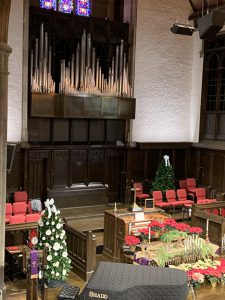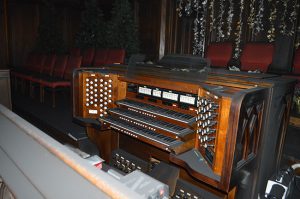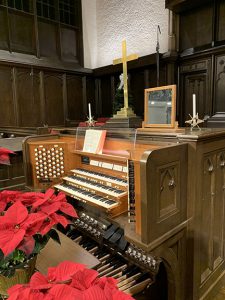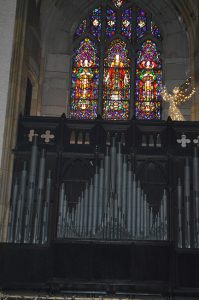Broadway United Methodist Church, Indianapolis
Broadway’s Trial by Fire

The church was dark.
It was a week before Christmas 2017 and the congregation had decorated every corner of the great building. In the sanctuary, dozens of red, white, and pink poinsettias had arranged around the console of the great pipe organ. In the small gallery high above the polished tin pipes a lighted angel cast a glow on the stained glass behind. Under the sanctuary, fellowship hall was festive with garland and lighted Christmas trees.
The day before, our tuning team had finished the first day of a two-day full tuning of both pipe organs, the two-manual 9-rank organ in the chapel and the three-manual 54 rank sanctuary instrument.
Broadway United Methodist Church is one of the great congregations in the inner-city of Indianapolis. Like many big downtown churches, Broadway had been a prosperous church during its “salad days.” But demographic changes to the city had caused the numbers to decline as members migrated to the suburbs. Sunday worship in the cavernous sanctuary became increasingly sparsely-attended, and evening activities were abandoned. It looked like Broadway United Methodist Church was experiencing a rapidly-moving death spiral.
But then something happened. The congregation still calls it the “miracle on 29th Street.” They made the uncomfortable choice to change. If their building was to be closed, if their congregation was to be disbanded, if Broadway’s story was to become history, they would use themselves up in service. The people of Broadway announced that they valued all people, and threw their doors open to all. The neighborhood responded. People of all sorts and from all segments of the community found a spiritual home at the big church on Fall Creek Boulevard. As the church grew, the leadership found new uses for the huge facility – uses that served the needs of the people.
In 2001, as the miracle took hold, Broadway embarking on an ambitious program of renovation. Their first major project was the replacement of the pipe organs in the sanctuary and chapel. Broadway has always been a musical church, with a fine choir, soloists, and instrumentalists. Increasingly, contemporary and ethnic music has become part of the mix as well. Reynolds Associates had cared for the old organs for several years, and when we were asked to design and build new instruments, we were delighted. Since then, both organs had been used every week in worship and the sanctuary organ had been the focus of many concerts and special events.

So this Christmas of 2017, Broadway had much to celebrate – much to be thankful for.
In fellowship hall, an acrid odor began to permeate the darkness. A spark flared, probably around a small plastic transformer, and the plastic tree ignited. As the fire caught, it spread to everything flammable, including the plastic banquet tables and chairs that filled the room. Later, investigators said that the fire had been “oxygen-starved.” With windows and doors closed tightly, the fire could not draw enough air to full support it. The result was a particularly sooty fire that was carried to every remote corner of the building. By the time the blaze was discovered and the last remnants extinguished by the Indianapolis Fire Department, the damage had been done. Every inch of every room of Broadway Church was covered with a thick coating of greasy soot.
Inside the organ chambers, all 3,000 pipes were covered inside and out with the soot. Windchests, reservoirs, windlines, nothing was spared in both organs. In the sanctuary, the console looked sooty, but in fact it was completely ruined. The console was directly over huge air exchangers that carried the smoke from fellowhip hall. This smoke and heat poured directly into the console cabinet. When we tried later to lift it out of its pit, it fell to pieces. This soot was very corrosive, and it penetrated all the electronics of the control system as well.

The building had no heat, and most of the electricity was off as well. The only light in the sanctuary came from the solitary angel high in the loft. Somehow, it seemed symbolic.
We were delayed several weeks getting started on the organs. During this time, cold, damp, and soot continued to do their damage. The insurance company had to do its due diligence before approving any work to the instrument. Finally, in late February, we got the go-ahead to begin work to save the organs.
Restoring the chapel organ was the first task, and by far the easiest. We cleaned all the pipes, cleaned and rebuilt the windchests, and replaced the console. By late spring, the chapel could be used again, and the organ was ready soon after.
The sanctuary organ was another matter. Every pipe was cleaned inside and out several times. The soot was stubborn, and a few days after a washing, a sooty haze would reappear. Cleaning out the 16′ Pedal Diapason pipes was particularly difficult. These pipes are over sixteen feet long, and were as filthy inside as out. Every piece of wood in the organ had to be solvent-washed and re-lacquered. Every piece of hardware – including thousands of screws, washers, and springs, had to be replaced.

At the same time, our firm already had commitments to other customers along with our regular service and tuning schedule. Meanwhile, professional building restoration services cleaned, scrubbed, and repainted every corner of the building. By Easter of 2019 the church was finally able to resume worship in its sanctuary while work on the organ continued.
Then came 2020. We were making good progress on the organ when the COVID19 pandemic struck. During the spring, we lost ten weeks as both we and the church followed the recommendations put in place by the authorities. When work resumed in the summer, there was a sense of unreality as we found our tools and the parts we were working on where we had left them months before. Although there wasn’t much left to do to finish the organ, parts that were needed from suppliers were delayed, making the small task of completing the job take months!
We completed the organ on December 17, 2020, three years to the day after the great fire. Broadway United Methodist Church shines now like a new penny, as do both of its pipe organs. Changes to materials covering the floors and ceilings of the sanctuary actually improved the acoustics, but required a number of adjustments to the pipes. At the end of the project, under the direction of David Reynolds, we carefully went through every pipe of every stop in the organ, checking and adjusting the regulation.
It is a mark of frustration that every project we tried to do in 2020 moved at the pace of frozen molasses. We managed to obey the rules, and were fortunate that none of us got sick.
Once the pandemic is over and society returns to normal, Broadway plans a rededication of its building and its organs. This series of crises has, if anything, made one of the city’s most vital congregations even stronger. We look forward to the big day when we can share Broadway’s reborn instruments with the community.
Soli Deo Gloria!